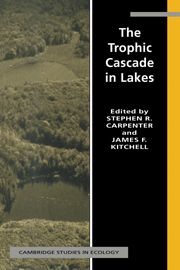Book contents
- Frontmatter
- Contents
- Contributors
- Preface
- 1 Cascading trophic interactions
- 2 Experimental lakes, manipulations and measurements
- 3 Statistical analysis of the ecosystem experiments
- 4 The fish populations
- 5 Fish behavioral and community responses to manipulation
- 6 Roles of fish predation: piscivory and planktivory
- 7 Dynamics of the phantom midge: implications for zooplankton
- 8 Zooplankton community dynamics
- 9 Effects of predators and food supply on diel vertical migration of Daphnia
- 10 Zooplankton biomass and body size
- 11 Phytoplankton community dynamics
- 12 Metalimnetic phytoplankton dynamics
- 13 Primary production and its interactions with nutrients and light transmission
- 14 Heterotrophic microbial processes
- 15 Annual fossil records of food-web manipulation
- 16 Simulation models of the trophic cascade: predictions and evaluations
- 17 Synthesis and new directions
- References
- Index
7 - Dynamics of the phantom midge: implications for zooplankton
Published online by Cambridge University Press: 06 August 2010
- Frontmatter
- Contents
- Contributors
- Preface
- 1 Cascading trophic interactions
- 2 Experimental lakes, manipulations and measurements
- 3 Statistical analysis of the ecosystem experiments
- 4 The fish populations
- 5 Fish behavioral and community responses to manipulation
- 6 Roles of fish predation: piscivory and planktivory
- 7 Dynamics of the phantom midge: implications for zooplankton
- 8 Zooplankton community dynamics
- 9 Effects of predators and food supply on diel vertical migration of Daphnia
- 10 Zooplankton biomass and body size
- 11 Phytoplankton community dynamics
- 12 Metalimnetic phytoplankton dynamics
- 13 Primary production and its interactions with nutrients and light transmission
- 14 Heterotrophic microbial processes
- 15 Annual fossil records of food-web manipulation
- 16 Simulation models of the trophic cascade: predictions and evaluations
- 17 Synthesis and new directions
- References
- Index
Summary
Introduction
Invertebrate planktivores occupy an intriguing position in the pelagic food web. Like other zooplankton, they are vulnerable to planktivory by fishes, yet they can prey heavily on certain zooplankton (Dodson, 1972; Neill, 1981; Black & Hairston, 1988; Hanazato & Yasuno, 1989). In Paul, Peter, and Tuesday Lakes, the most important invertebrate planktivores are larvae of three species of Chaoborus, the phantom midge. Owing, in part, to behavioral responses and ontogenetic diet shifts of both fishes and Chaoborus, the interaction between the two and consequences for zooplankton communities can be difficult to predict (Luecke, 1986; Elser et al., 1987b; Neill, 1988; Hanazato & Yasuno, 1989). The trophic cascade hypothesis states that planktivory by invertebrates is inversely related to planktivory by fishes (Carpenter et al., 1985). Nevertheless, we anticipated little change in Chaoborus during our experiments, because of their cryptic morphology and pronounced diel vertical migration behavior (Carpenter & Kitchell, 1987). Here we examine how Chaoborus populations responded to the fish manipulations, and consider the consequences for the trophic cascade.
Chaoborus develop through four instars as planktonic larvae before pupating. Their body is relatively transparent, except for well-developed hydrostatic organs, hence the common name phantom midge (Fig. 8.1, Chapter 8). Nevertheless, they are susceptible to predation by fishes. In lakes with fish, third- and fourth-instar Chaoborus will spend the days in either the hypolimnion, metalimnion, or bottom sediments and come to the surface at night to feed (Roth, 1968; von Ende, 1979; Luecke, 1986).
- Type
- Chapter
- Information
- The Trophic Cascade in Lakes , pp. 103 - 115Publisher: Cambridge University PressPrint publication year: 1993
- 13
- Cited by



